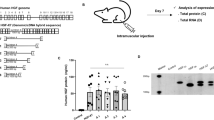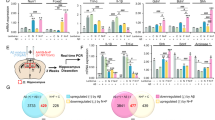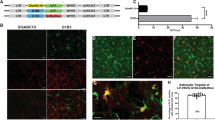Abstract
The central nervous system (CNS) is a site of relative immunological privilege; despite this it can be a target of the immune system under certain conditions. For example, adenoviral vectors elicit an immune response strong enough to result in antigen elimination, in immunologically primed animals. Fas ligand (FasL) contributes to the immune privilege of certain tissues by inducing apoptosis in activated T cells. We therefore investigated whether local overexpression of FasL could downregulate the immune response to adenovirus in the brain. Adenoviral vectors expressing FasL (AdFasL) and the reporter gene β-galactosidase (Adβgal) were co-injected into the striatum of naïve or immunologically primed mice. A co-injection of an adenovirus lacking a transgene (Ad0) and Adβgal acted as a control. At 2 weeks after inoculation, reporter protein expression was significantly reduced with the AdFasL:Adβgal combination compared with the Ad0:Adβgal controls. This was accompanied by a strong inflammatory cell infiltrate, local demyelination and upregulation of pro-inflammatory cytokine gene expression. These experiments demonstrate that FasL overexpression elicits a pro-inflammatory response in the CNS rather than immunosuppression. This was characterized by chronic inflammation and accelerated loss of transgene expression. Induction of such an unexpected pro-inflammatory response caused by introducing FasL may be a peculiarity of the relative immunoprivilege of the unique environment of the brain.
This is a preview of subscription content, access via your institution
Access options
Subscribe to this journal
Receive 12 print issues and online access
$259.00 per year
only $21.58 per issue
Buy this article
- Purchase on Springer Link
- Instant access to full article PDF
Prices may be subject to local taxes which are calculated during checkout











Similar content being viewed by others
References
Yednock TA et al. Prevention of experimental autoimmune encephalomyelitis by antibodies against alpha 4 beta 1 integrin. Nature 1992; 356: 63–66.
Matyszak MK, Perry VH . Demyelination in the central nervous system following a delayed-type hypersensitivity response to bacillus Calmette-Guerin. Neuroscience 1995; 64: 967–977.
Wood MJ et al. Immune responses to adenovirus vectors in the nervous system. Trends Neurosci 1996; 19: 497–501.
Hickey WF, Hsu BL, Kimura H . T-lymphocyte entry into the central nervous system. J Neurosci Res 1991; 28: 254–260.
Wisniewski HM, Bloom BR . Primary demyelination as a nonspecific consequence of a cell-mediated immune reaction. J Exp Med 1975; 141: 346–359.
Borrow P, Cornell JL, Ruppe MD, Mucke L . Immunization-induced inflammatory infiltration of the central nervous system in transgenic mice expressing a microbial antigen in astrocytes. J Neuroimmunol 1995; 61: 133–149.
Duan WM, Widner H, Frodl EM, Brundin P . Immune reactions following systemic immunization prior or subsequent to intrastriatal transplantation of allogeneic mesencephalic tissue in adult rats. Neuroscience 1995; 64: 629–641.
Rosenfeld MA et al. Adenovirus-mediated transfer of a recombinant alpha 1-antitrypsin gene to the lung epithelium in vivo. Science 1991; 252: 431–434.
Li Q et al. Assessment of recombinant adenoviral vectors for hepatic gene therapy. Hum Gene Ther 1993; 4: 403–409.
Yang Y et al. Cellular immunity to viral antigens limits E1-deleted adenoviruses for gene therapy. Proc Natl Acad Sci USA 1994; 91: 4407–4411.
Yang Y et al. Immune responses to viral antigens versus transgene product in the elimination of recombinant adenovirus-infected hepatocytes in vivo. Gene Ther 1996; 3: 137–144.
Davidson BL et al. A model system for in vivo gene transfer into the central nervous system using an adenoviral vector. Nat Genet 1993; 3: 219–223.
Byrnes AP, Rusby JE, Wood MJ, Charlton HM . Adenovirus gene transfer causes inflammation in the brain. Neuroscience 1995; 66: 1015–1024.
O'Leary MT, Charlton HM . A model for long-term transgene expression in spinal cord regeneration studies. Gene Ther 1999; 6: 1351–1359.
Zsengeller ZK et al. Persistence of replication-deficient adenovirus-mediated gene transfer in lungs of immune-deficient (nu/nu) mice. Hum Gene Ther 1995; 6: 457–467.
Kass-Eisler A et al. The impact of developmental stage, route of administration and the immune system on adenovirus-mediated gene transfer. Gene Ther 1994; 1: 395–402.
Dai Y et al. Cellular and humoral immune responses to adenoviral vectors containing factor IX gene: tolerization of factor IX and vector antigens allows for long-term expression. Proc Natl Acad Sci USA 1995; 92: 1401–1405.
Kass-Eisler A et al. Circumventing the immune response to adenovirus-mediated gene therapy. Gene Ther 1996; 3: 154–162.
McClane SJ, Chirmule N, Burke CV, Raper SE . Characterization of the immune response after local delivery of recombinant adenovirus in murine pancreas and successful strategies for readministration. Hum Gene Ther 1997; 8: 2207–2216.
Yang Y, Ertl HC, Wilson JM . MHC class I-restricted cytotoxic T lymphocytes to viral antigens destroy hepatocytes in mice infected with E1-deleted recombinant adenoviruses. Immunity 1994; 1: 433–442.
Yang Y, Wilson JM . Clearance of adenovirus-infected hepatocytes by MHC class I-restricted CD4+ CTLs in vivo. J Immunol 1995; 155: 2564–2570.
Byrnes AP, Wood MJ, Charlton HM . Role of T cells in inflammation caused by adenovirus vectors in the brain. Gene Ther 1996; 3: 644–651.
Jooss K, Ertl HC, Wilson JM . Cytotoxic T-lymphocyte target proteins and their major histocompatibility complex class I restriction in response to adenovirus vectors delivered to mouse liver. J Virol 1998; 72: 2945–2954.
Brunner T et al. Cell-autonomous Fas (CD95)/Fas-ligand interaction mediates activation-induced apoptosis in T-cell hybridomas. Nature 1995; 373: 441–444.
Dhein J et al. Autocrine T-cell suicide mediated by APO-1/(Fas/CD95). Nature 1995; 373: 438–441.
Ju ST et al. Fas(CD95)/FasL interactions required for programmed cell death after T-cell activation. Nature 1995; 373: 444–448.
Yonehara S, Ishii A, Yonehara M . A cell-killing monoclonal antibody (anti-Fas) to a cell surface antigen co-downregulated with the receptor of tumor necrosis factor. J Exp Med 1989; 169: 1747–1756.
Nagata S, Golstein P . The Fas death factor. Science 1995; 267: 1449–1456.
Walsh K, Sata M . Is extravasation a Fas-regulated process? Mol Med Today 1999; 5: 61–67.
Bellgrau D et al. A role for CD95 ligand in preventing graft rejection. Nature 1995; 377: 630–632.
Griffith TS et al. Fas ligand-induced apoptosis as a mechanism of immune privilege. Science 1995; 270: 1189–1192.
Sanberg PR, Borlongan CV, Saporta S, Cameron DF . Testis-derived Sertoli cells survive and provide localized immunoprotection for xenografts in rat brain. Nat Biotechnol 1996; 14: 1692–1695.
Saporta S, Cameron DF, Borlongan CV, Sanberg PR . Survival of rat and porcine Sertoli cell transplants in the rat striatum without cyclosporine -A immunosuppression. Exp Neurol 1997; 146: 299–304.
Willing AE, Cameron DF, Sanberg PR . Sertoli cell transplants: their use in the treatment of neurodegenerative disease. Mol Med Today 1998; 4: 471–477.
Kajiwara K et al. Immune responses to adenoviral vectors during gene transfer in the brain. Hum Gene Ther 1997; 8: 253–265.
Mason DW et al. The fate of allogeneic and xenogeneic neuronal tissue transplanted into the third ventricle of rodents. Neuroscience 1986; 19: 685–694.
Thomas CE et al. Peripheral infection with adenovirus causes unexpected long-term brain inflammation in animals injected intracranially with first-generation, but not with high-capacity, adenovirus vectors: toward realistic long-term neurological gene therapy for chronic diseases. Proc Natl Acad Sci USA 2000; 97: 7482–7487.
Wong GH et al. Inducible expression of H-2 and Ia antigens on brain cells. Nature 1984; 310: 688–691.
Suzumura A, Silberberg DH, Lisak RP . The expression of MHC antigens on oligodendrocytes: induction of polymorphic H-2 expression by lymphokines. J Neuroimmunol 1986; 11: 179–190.
Vass K, Lassmann H . Intrathecal application of interferon gamma. Progressive appearance of MHC antigens within the rat nervous system. Am J Pathol 1990; 137: 789–800.
Nelson DP et al. Proinflammatory consequences of transgenic fas ligand expression in the heart. J Clin Invest 2000; 105: 1199–1208.
Kang SM et al. Fas ligand expression in islets of Langerhans does not confer immune privilege and instead targets them for rapid destruction. Nat Med 1997; 3: 738–743.
Muruve DA et al. Adenovirus-mediated expression of Fas ligand induces hepatic apoptosis after Systemic administration and apoptosis of ex vivo-infected pancreatic islet allografts and isografts. Hum Gene Ther 1997; 8: 955–963.
O'Connell J et al. Immune privilege or inflammation? Insights into the Fas ligand enigma. Nat Med 2001; 7: 271–274.
Schaub FJ et al. Fas/FADD-mediated activation of a specific program of inflammatory gene expression in vascular smooth muscle cells. Nat Med 2000; 6: 790–796.
Saas P et al. TWEAK stimulation of astrocytes and the proinflammatory consequences. Glia 2000; 32: 102–107.
D'Souza SD et al. Multiple sclerosis: Fas signaling in oligodendrocyte cell death. J Exp Med 1996; 184: 2361–2370.
Dowling P et al. Involvement of the CD95 (APO-1/Fas) receptor/ligand system in multiple sclerosis brain. J Exp Med 1996; 184: 1513–1518.
Yagita H, Seino K, Kayagaki N, Okumura K . CD95 ligand in graft rejection. Nature 1996; 379: 682.
Chen JJ, Sun Y, Nabel GJ . Regulation of the proinflammatory effects of Fas ligand (CD95L). Science 1998; 282: 1714–1717.
Seino K, Kayagaki N, Okumura K, Yagita H . Antitumor effect of locally produced CD95 ligand. Nat Med 1997; 3: 165–170.
Igney FH, Behrens CK, Krammer PH . Tumor counterattack – concept and reality. Eur J Immunol 2000; 30: 725–731.
Zhan HG et al. Specific deletion of autoreactive T cells by adenovirus-transfected, Fas ligand-producing antigen-presenting cells. Immunol Res 2002; 26: 235–246.
Springer T, Galfre G, Secher DS, Milstein C . Monoclonal xenogeneic antibodies to murine cell surface antigens: identification of novel leukocyte differentiation antigens. Eur J Immunol 1978; 8: 539–551.
Springer T (ed). Cell-Surface Differentiation in the Mouse. Characterisation of ‘Jumping’ and ‘Lineage’ Antigens Using Xenogeneic Rat Monoclonal Antibodies. Plenum Press: New York, 1980.
Rabinowitz SS, Gordon S . Macrosialin, a macrophage-restricted membrane sialoprotein differentially glycosylated in response to inflammatory stimuli. J Exp Med 1991; 174: 827–836.
Tomonari K . A rat antibody against a structure functionally related to the mouse T-cell receptor/T3 complex. Immunogenetics 1988; 28: 455–458.
Vine AM, Lang J, Wood MJ, Charlton HM . Cytokine gene expression following neural grafts. Exp Brain Res 1999; 126: 281–288.
Acknowledgements
This work was supported by The Wellcome Trust (UK). ELR was the recipient of a Wellcome Prize Studentship. We are particularly grateful to Dr Libermann for the generous gift of the FasL adenovirus.
Author information
Authors and Affiliations
Rights and permissions
About this article
Cite this article
Regardsoe, E., McMenamin, M., Charlton, H. et al. Local adenoviral expression of Fas ligand upregulates pro-inflammatory immune responses in the CNS. Gene Ther 11, 1462–1474 (2004). https://doi.org/10.1038/sj.gt.3302322
Received:
Accepted:
Published:
Issue Date:
DOI: https://doi.org/10.1038/sj.gt.3302322
Keywords
This article is cited by
-
Inflammation, Apoptosis, and Necrosis Induced by Neoadjuvant Fas Ligand Gene Therapy Improves Survival of Dogs With Spontaneous Bone Cancer
Molecular Therapy (2012)
-
Absence of an intrathecal immune reaction to a helper-dependent adenoviral vector delivered into the cerebrospinal fluid of non-human primates
Gene Therapy (2008)
-
IL4 gene delivery to the CNS recruits regulatory T cells and induces clinical recovery in mouse models of multiple sclerosis
Gene Therapy (2008)



